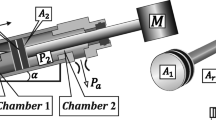Abstract
One type of automatic medical tele-robotics system that is used in Percutaneous Puncture Surgery has been presented in this paper. A compensation (or synchronous) method for physiological movement is a necessary control method to reduce the difficulty of operations and improve operating accuracy for an automatic Percutaneous Puncture Surgical Robot (PPSR). Firstly, the robotics system can put a surgeon away from X-ray radiation. Secondly and importantly, the control system of the Robot is based on an Iterative Learning Control (ILC) algorithm which is a dual channel synchronous control system. The puncture actuator controlling channel is in charge of automatically inserting a needle and compensating for the motion of the internal organs. The robotic arm controlling channel is in charge of controlling the direction of the needle and compensating for the body’s external inserting point motion with the on-line supervision. The performance of the control system has been evaluated and simulated in MATLAB. The results have been proven that the control process is effective.






















Similar content being viewed by others
References
Alexandre B, Zhou J, Yang G et al (2009) Motion compensated tomography reconstruction of coronary arteries in rotational angiography[J]. IEEE Trans Biomed Eng 56(4):1254–1257
Bruno D, Calinon S, Caldwell DG (2017) Learning autonomous behaviours for the body of a flexible surgical robot[M]. Kluwer Academic Publishers
Cagneau B, Zemiti N, Bellot D, et al. (2007) Physiological motion compensation in robotized surgery using force feedback control[C]// IEEE international conference on robotics and automation. IEEE, 1881–1886
Dominici M, Rui C. (2014) Cascade robot force control architecture for autonomous beating heart motion compensation with model predictive control and active observer[C]// biomedical robotics and biomechatronics. IEEE, 745–751
Ginhoux R, Gangloff J, Mathelin MD et al (2005) Active filtering of physiological motion in robotized surgery using predictive control[J]. IEEE Trans Robot 21(1):67–79
Huang SY (2003) Synchronized moving aperture radiation therapy (SMART): average tumour trajectory for lung patients. Phys Med Biol 48(5):587–598
Inoue T, Matsuno T, Yanou A, et al. (2014) Development of a minimally invasive robotic interventional radiology for treatment of lung cancer -manufacture of a basic mechanism and verification experiment-[C]// Sice conference. IEEE, 2646–2651
Kobayashi Y, Moreira P, Liu C et al (2011) Haptic feedback control in medical robots through fractional viscoelastic tissue model[J]. Conf Proc IEEE Eng Med Biol Soc 2011(4):6704–6708
Ligorio G, Sabatini AMA (2015) Novel Kalman filter for human motion tracking with an inertial-based dynamic inclinometer[J]. IEEE Trans Biomed Eng 62(8):2033–2043
Murphy MJ (2004) Tracking moving organs in real time.[J]. Semin Radiat Oncol 14(1):91
Nakamura Y, Kishi K, Kawakami H. (2001) Heartbeat synchronization for robotic cardiac surgery[C]// proc. Of IEEE international conference on robotics and automation. 2014–2019 vol.2
Prakosa A, Sermesant M, Allain P et al (2014) Cardiac electrophysiological activation pattern estimation from images using a patient-specific database of synthetic image sequences[J]. IEEE Trans Biomed Eng 61(2):235–245
Qu J, Li J, Zhang L, et al. (2013) Design of a novel force-reflecting haptic device for minimally invasive surgery robot[C]// ICME international conference on complex medical engineering. IEEE, 357–362
Richa R, Bó APL, Poignet P (2010) Beating heart motion prediction for robust visual tracking[C]// IEEE international conference on robotics and automation. IEEE, 4579–4584
Sharifi M, Salarieh H, Behzadipour S, Tavakoli M (2017) Tele-echography of moving organs using an Impedance-controlled telerobotic system [J] mechatronics, 05
Strååt SJ (2012) Verification of high energy photon therapy based on PET/CT imaging of photonuclear reactions[J]. Department of Physics
Vidal FP, Villard PF (2016) Development and validation of real-time simulation of X-ray imaging with respiratory motion[J]. Computerized Medical Imaging & Graphics the Official Journal of the Computerized Medical Imaging Society 49:1–15
Wood NA, Agua DMD, Zenati MA, et al. (2011) Position estimation of an epicardial crawling robot on the beating heart by modeling of physiological motion[C]// Ieee/rsj international conference on intelligent robots and systems. IEEE, 4522–4527.
Zarrouk Z, Chemori A, Poignet P (2013) Force feedback control for compensation of physiological motions in beating heart surgery with real-time experiments[J]:956–961
Author information
Authors and Affiliations
Corresponding author
Additional information
Publisher’s note
Springer Nature remains neutral with regard to jurisdictional claims in published maps and institutional affiliations.
Rights and permissions
About this article
Cite this article
Wang, L., Hu, T. The design of a dual channel synchronous control system based on a new percutaneous puncture surgical robot. Multimed Tools Appl 79, 10405–10425 (2020). https://doi.org/10.1007/s11042-019-07891-9
Received:
Revised:
Accepted:
Published:
Issue Date:
DOI: https://doi.org/10.1007/s11042-019-07891-9




